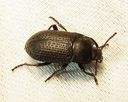Asiopus
Asiopus
Classification
- Phylum: Arthropoda
- Subphylum: Hexapoda
- Class: Insecta
- Order: Coleoptera
- Suborder: Polyphaga
- Superfamily: Tenebrionoidea
- Family: Tenebrionidae
- Subfamily: Blaptinae
- Tribe: Platynotini
- Genus: Asiopus
Pronunciation
How to pronounce Asiopus: //əˈsaɪ.ə.pəs//
These audio files are automatically generated. While they are not always 100% accurate, they are a good starting point.
Images

Summary
Asiopus is a genus of beetles in the family Tenebrionidae, which are characterized by their long joints and ecological role in decomposition.
Physical Characteristics
Typically characterized by their elongated bodies and long, distinct joints in the legs and antennae.
Identification Tips
Look for elongated beetles with a smooth, shiny surface; they often have a dark coloration.
Habitat
Found in various habitats including forests, grasslands, and disturbed areas.
Distribution
Primarily found in North America, with additional species in other regions.
Diet
Herbivorous, feeding on decaying plant material and fungi.
Life Cycle
Undergo complete metamorphosis: egg, larva, pupa, and adult stages.
Reproduction
Mating occurs in the spring; females lay eggs in decaying organic matter.
Predators
Birds, predacious insects, and other animals may prey on adult beetles and larvae.
Conservation Status
Not currently listed as threatened or endangered; populations are stable.
Ecosystem Role
Play a role in decomposition and nutrient cycling by breaking down plant materials.
Economic Impact
Generally considered non-pest species; may have an impact on the decomposition of organic matter in agricultural settings.
Evolution
Formerly treated as a subgenus of Opatrinus and as Alaetrinus, indicating an evolutionary relationship within the Tenebrionidae family.
Similar Taxa
- Opatrinus
- Alaetrinus
Misconceptions
May be confused with other dark-colored beetles; important to note their elongated body form is distinct.
Tags
- beetles
- insect
- coleoptera
- Tenebrionidae
- Asiopus